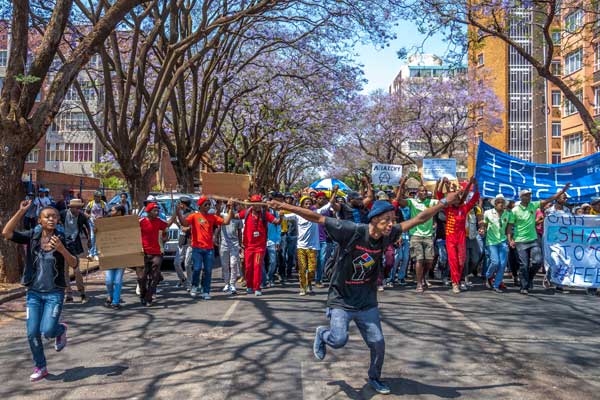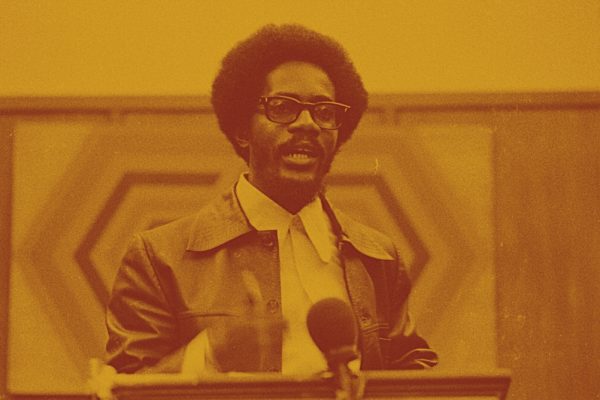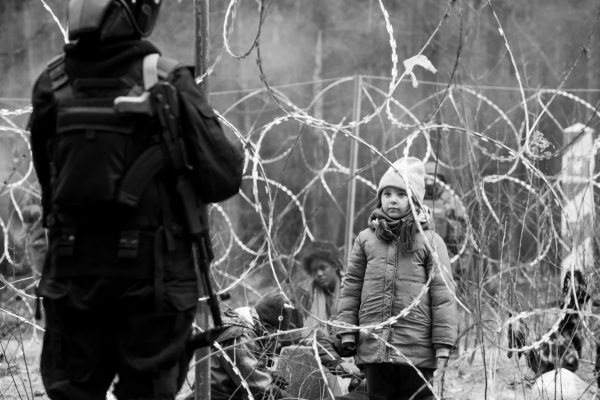In October 2015, South African college students protested universities’ plans to raise tuition for 2016 by 10 percent or more. Organizing under the banner of #FeesMustFall (FMF), the movement gained momentum at University of the Witwatersrand in Johannesburg—one of the country’s most prestigious schools—before rapidly spreading to other universities, bringing campus activities to a grinding halt nationwide. The success of the student movement has the potential to nurture the creation of a stable, unprecedented, and politically relevant alliance between the country’s various disenfranchised groups. This may mark the beginning of a new phase in South African democracy: the emergence of much needed participatory structures to address the needs and aspirations of the majority in what remains, at present, a highly unequal system.
South African public universities receive their largest share of income from the national government, but state funding has declined over the years. They have the autonomy to set tuition fees. Over the past few years, these have crept to exorbitant highs, now beyond the reach of most South Africans. Meanwhile, state-funded university scholarships have limited reach. FMF activists demanded foremost that all planned increases in university tuition be cancelled.
Nationwide, thousands of students joined demonstrations taking place on and around university campuses. Two mass marches stood out: one at the national parliament in Cape Town on October 21; the other, two days later, saw protesters gathered outside President Jacob Zuma’s offices in Pretoria, the seat of the executive branch. The second demonstration proved decisive. The same afternoon, President Zuma announced a moratorium on raising university fees for 2016 and established a taskforce to address issues that emerged from the unrest.
Despite the victory, smaller crowds continued to protest well into November, successfully disrupting end-of-year exams. Demands varied across campuses, but key among them were the forgiveness of student debt and an end to the exploitative practice of using underpaid, third-party contracted workers (a practice called “outsourcing”). Protests pushed some universities to commit to insourcing, while others agreed to provide debt relief to students.
Twenty-one years after the first democratic elections, South Africa remains one of the most unequal countries on earth.
These immediate demands were informed by two larger, long-term desires, shared among many protesters, for free higher education and redress of the stark racial disparities that persist in the sector. Indisputably, South African universities remain racially stratified. Those that catered to whites during apartheid continue to benefit from this legacy: the top South African performers in international rankings come from this group. Often they remain racially unintegrated in all but name. They still have more resources than their formerly “black” competitors, and their faculty and student demographics skew disproportionately white.
No less insidious, university curricula nationwide reflect a Eurocentric view of the world. In the social sciences, for example, the study of Western theorists and methodologies dominates undergraduate and postgraduate courses. Even where African scholars and approaches are considered, students complain that they are debated through the lenses of Western academia, rather than the perspectives and concerns of black South Africans.
These inequalities in higher education mirror the challenges facing South African society at large. Twenty-one years after the first democratic elections, South Africa remains one of the most unequal countries on earth. Tragically, given its history, its social and economic inequalities are primarily articulated along racial lines. The vast majority of black South Africans and other historically disadvantaged groups continue to be excluded from the centers of economic wealth and political power. Whites hold on to their privileged economic position, in alliance with a tiny black elite that controls the government, having benefited from limited ownership transfer deals in the private sector. Majority ownership in mining and other key economic sectors remains in the hands of local whites and investors from Western countries. Most blacks are de facto segregated in areas that suffer from structural disadvantage and widespread poverty. Moreover, those black citizens living and working in privileged areas still experience the dehumanizing effects of racism. Even where whiteness has moved to the background, class, gender and ethnic divisions exacerbated by economic inequalities fuel major tensions.
It is with a keen awareness of this context that the word “decolonization” has been embraced by some FMF leaders to contextualize their activism as a facet of a broader strategy to dismantle white privilege in the country. This investment in the decolonization of South African higher education encourages us to interpret #FeesMustFall as only the latest chapter—and certainly not the last—in a larger project that had its beginning in another wave of student activism, #RhodesMustFall, which took place in March and April 2015. The movement, centered on the University of Cape Town, successfully sought the removal of a campus statue of Cecil Rhodes, the British mining magnate who was pivotal in expanding the influence of white settlers in Rhodesia, now Zambia and Zimbabwe, at the end of the nineteenth century.
Many students saw the statue as a powerful symbol of colonial domination, and hailed its removal as the beginning of a new journey to reverse the legacy of apartheid and emancipate black people from the chains of oppression. This kind of symbolic justice, achieved through collective ritual, often satisfied private needs as well, enacting a rebirth of sorts for individual participants. Narratives collected from student participants often stress the need to remember the pain that black people suffered during apartheid, an oppression that persists in their current everyday struggles with a system that works against them. The shorthand many use for the powerful entanglement of memory, experience, and identity is “black pain.”
Liberation is not merely an economic or social project, but an intrapsychic process aimed at creating new identities and forms of agency freed from the yoke of the colonizer. In this self-work, the reversal or removal of the symbols of oppression can be as important as the structural work of changing the discriminatory institutions that perpetuate poverty. The main intellectual reference points for these emerging practices are the works of Frantz Fanon and South African anti-apartheid activist Steve Biko.
The project is at odds with late President Nelson Mandela’s vision of the “rainbow nation.” Mandela and his party, the African National Congress (ANC), attempted a transition from apartheid to democracy on the foundations of a non-racial ideology that included former colonizers as legitimate citizens of the new state. As a result, local whites and Western investors were involved in the negotiations leading to the establishment of the new post-apartheid order. The assumption was that a consensual process would lead to the voluntary redress of racial and class inequalities. There was no space in the process for symbolic justice of the kind advocated by student activists: in an analog to recent struggles in the United States over the Confederate flag, the very same symbols identified by black South Africans as oppressive have been defended by many whites as historical heritage.
As importantly, the negotiated consensus failed to produce any significant redistribution of capital or resources to the excluded black majority. At the time of the transition to democracy, there were competing visions of the economy within the ANC. Despite the presence of a communist element within the government alliance—the South African Communist Party is a formal ally of the ANC—the ANC leaders never agreed on a full nationalization of the economy. Other less radical options were nonetheless popular, and included mixed economy models and social democratic mechanisms of redistribution. Mandela and his colleagues’ aspirations for economic and social justice were not in question, and there were high expectations among the populace that a new South Africa had to deliver most people from poverty and economic discrimination. However, the negotiations concluded with ANC leaders capitulating on the equality agenda. An important factor playing against the ANC then was that the global zeitgeist was decidedly neoliberal. The Soviet Union had recently collapsed, and leftist parties worldwide quickly embraced free market ideology.
The methods and tactics employed by student protesters in 2015 clearly show a deep disillusionment with the structures of representative democracy that failed to deliver on the high expectations fueled by the end of apartheid. The most significant factor that united student protesters across racial and class groups was probably their shared distrust of any leadership that would attempt to impose conventional forms of representative government. Leaderless crowds marched on places of economic privilege and political power, refusing to be led by student and civil society organizations with close ties to the ruling party, the ANC. They also opposed attempts by the main opposition party, the Democratic Alliance (widely perceived as aligned with white interests), to ride the wave.
While the height of the #FeesMustFall movement only lasted a few days, the smaller groups of protesters that continued their actions well into November took charge in crafting more structured narratives of discontent. While they do not necessarily “represent” the crowds, they have become in many ways the spokespeople for the movement. In practical terms, they have been involved in the tense and ongoing negotiations with university management over how to fulfill the protesters’ demands.
These more articulated sections of the movement privilege direct action and flat decision-making structures, showing similarities with Occupy movements and Black Lives Matter (BLM) in the United States. The relationship with the latter is not accidental, as student activists from both countries have fostered ties of solidarity and exchange through physical meetings on both sides of the Atlantic. While demonstrations were still ongoing in South Africa, student protests erupted in the United States, and BLM played a central role. Issues of racism and failures of leadership were prominent in both settings, and FMF activists were quick to make the links on social media, with some claiming that the South African protests had in fact inspired American students. Ideas of black consciousness in South Africa find more resonances with BLM in the United States than with less racialized philosophies of liberation in other parts of Africa. In most African countries, the difficulties of decolonization were not further aggravated by the presence of large white settler populations. Another similarity between FMF and BLM, shared with many new social movements across the world, is the crucial role played by the integration of social media activism with face-to-face meetings and actions.
It is time to resuscitate the process left incomplete by the Truth and Reconciliation Commission.
In practice, South African students’ desire to radically change the current configurations of racial discrimination through horizontal spontaneous action results in a paradoxical situation. Protesters reject attempts from the top to impose bureaucratic structures to channel their demands because they rightly fear that these processes would neutralize their call for change. At the same time, their refusal can act as an obstacle to the creation of a structured grassroots dialogue that could give long-term direction to their actions. On the other side of the equation, most university managers and government officials seem reluctant to change their exclusive and obscure decision-making processes, thus reinforcing protesters’ distrust.
A similar conundrum characterized other waves of spontaneous mass unrest experienced in South Africa in recent years, from wildcat strikes in the mining sector that culminated in the massacre of thirty-four miners by the police in Marikana in 2012, to service delivery protests successfully used by poor communities to obtain basic public services like drinking water and electricity. For many years class, ethnic, and gender rifts have prevented the formation of a durable national alliance among different marginalized groups. For the first time in the post-apartheid period, things might be changing and a convergence of sorts is already emerging.
In another sudden twist of events, thousands of protesters took to the streets across South Africa on December 16 under the banner of #ZumaMustFall, asking for Jacob Zuma’s removal from the presidency. The spark that ignited the fire was the sacking of respected finance minister Nhlanhla Nene. The demonstrations have been criticized by influential FMF voices as largely a “white” response that does not take stock of the decolonization project, and has a narrow view of what the underlying causes of the current systemic crises are. Even though FMF groups are generally very critical of Zuma and the ANC, many feel that white people cannot be of much help in their struggle—in fact, they are generally perceived as part of the problem.
The Economic Freedom Fighters (EFF), a young political party led by former leader of the ANC Youth League Julius Malema, are among the harshest critics of ANC rule, but have also criticized the recent anti-Zuma marches. The EFF might become the political catalyst that will lead to a more structured alliance against the systemic connivance of white interests and the ruling black elite. They entered parliament in numbers at their first attempt in 2014, and introduced in the political mainstream popular calls for economic redistribution from privileged groups to the excluded black majority. They refined spontaneous protest tactics into a coordinated plan of action inside and outside parliament, offering a broader narrative that connects the dots across apparently disparate concerns. At the end of October 2015, while student demonstrations were still ongoing, forty thousand EFF supporters marched to the Chamber of Mines and the Johannesburg Stock Exchange. They linked student demands for change to a wider social movement pushing for nationalization of mining and radical redistribution of land.
These waves of mass discontent can no longer be dismissed as random outbursts. 2016 will be a crucial year to see if the ANC, in power since the first democratic elections in 1994, will be able to change its course and avert further instability. FMF groups have declared their intention to continue with their struggles until their long-term goals are achieved. Local elections across all South African municipalities, to be held later in the year, will help keep tensions high. Options are limited and time is running out.
Government intervention in university matters is now unavoidable. Institutional autonomy has delayed the creation and implementation of wide-ranging policies to address racial and economic inequalities within and across universities. However, government action is not likely to be effective if suspicion and mistrust persist. White interests are on the whole resistant to intervention by a black government in what they see as “their” affairs. FMF groups are also generally distrustful of the ANC. There is a need for a coordinated effort to integrate government oversight with a grassroots participatory dialogue that brings together all constituencies—university managers, students, academics, workers, and other civil organizations.
It is time to resuscitate the important process initiated by the Truth and Reconciliation Commission after 1994, but left incomplete. Twenty-one years after the election of the first democratic government, it could be tempting to discard what leaders like Nelson Mandela and Desmond Tutu accomplished in the transition to the new dispensation. Their relentless call for dialogue and reconciliation averted an outright explosion of underlying social cleavages. Unfortunately, that danger remains. The compromise reached then did not address the crucial need for the redistribution of wealth and opportunities from privileged groups to marginalized ones. Just like the miners in Marikana, and the township residents involved in service delivery protests, university students and workers have now made their demands clear. They want radical change, and they are tired of waiting.
If South Africans do not want to be trapped in a state where mass unrest permanently batters itself again exclusionary islands of wealth and power, a solution has to emerge. The unfinished work painfully started by the leaders of the new South Africa in the 1990s needs to be completed soon. The reconciliation effort should focus on both symbolic and economic justice this time. Two decades of unequal democracy have shown that one without the other cannot bring about true emancipation.








